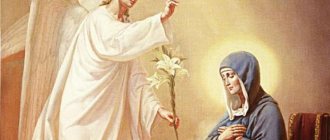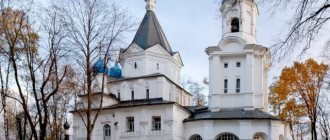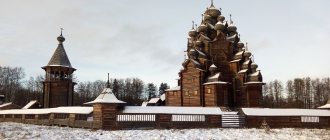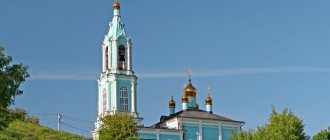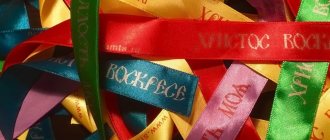Written sources
The Gospel says nothing about the Feast of the Entry. This event is narrated by Church Tradition, which complements the Holy Scriptures. Details about the earthly life of the Mother of God and the Feast of the Entry are set out in the apocrypha “Proto-Gospel of James” and “Gospel of Pseudo-Matthew”. The Holy Fathers of the Church wrote about the Entry into the Temple of the Most Holy Theotokos and Ever-Virgin Mary:
- George of Nicomedia;
- Theophylact of Bulgaria;
- Tarasius Archbishop of Constantinople;
- Herman, Archbishop of Constantinople;
- Gregory Palamas.
The Great Synaxarion (part of the Church Rules) contains an essay by an unknown author about the Entry of the Most Holy Theotokos into the Temple. Metropolitan Macarius collected all the texts about the holiday of the Great Menaion.
Establishment of the Feast of the Introduction
The Feast of the Entry is currently one of the twelve, but it was established in the Church later than others of this number. Perhaps its appearance is connected with the activities of Emperor Justinian I, who in 543 built a huge church on the ruins of the Jerusalem Temple, dedicated to the Most Holy Theotokos and which he called New to distinguish it from the previous one, located near the Sheep Font, opposite the temple [1].
In the 8th century The holiday is celebrated in some monthly words. Their restrained instructions apparently indicate that initially the service for the Entry was performed without much solemnity. The Patriarch of Constantinople Germanus I († 733) is credited with 2 homilies for the Introduction. [2], which may indicate the celebration of the Entry in Constantinople at that time. From v. the holiday becomes widespread in the East [3].
The status of the holiday gradually changed, in the Orthodox Church the Introduction finally became one of the twelfths only after the 14th century. - Theodore Prodromus (XII century) and Nicephorus Callistus (XIV century) [4] did not yet include it in this number [5] - but according to the Studite and Jerusalem Typicons - XIV centuries. it is celebrated almost as solemnly as other twelve holidays. Nevertheless, even in printed Typicons of the 17th century. Certain features of the service of the Introduction indicate that the status of this holiday is somewhat inferior to that of the Twelve.
The date of the holiday is almost universally accepted as November 21, with the exception of Coptic monthbooks, in which the Introduction is celebrated on November 29 (Sergius (Spassky). Monthology. T. 1. P. 395), and the practices of certain areas of the Roman Church, where the Introduction was a mobile holiday and was celebrated on Sunday after November 11.
A story about a miracle
The history of the holiday is amazing. A girl is born to barren elderly spouses. An angel appears to the parents and announces to them about the miracle that the Lord will do with them. God exalted the spouses, despised by their fellow tribesmen for imaginary sins and lack of children: Joachim and Anna became Godfathers .
Just as miraculous was the Conception of the Most Holy Theotokos, so miraculous was the Presentation of the Virgin Mary into the temple. According to the vow that Anna made to the Lord, the gifted Child should have been dedicated to the Creator. Joachim and Anna led their daughter from Nazareth to the Jerusalem Temple in a solemn procession. The three-year-old girl herself ran up the 15 high steps leading to the temple, where she was met by the high priest Zechariah. Then, under the inspiration of the Holy Spirit, Zechariah introduced the Virgin Mary, the Tabernacle of the New Testament, into the Holy of Holies. The ark of the Covenant was kept in the Holy of Holies, and only the high priest could enter there once a year. According to Tradition, the Most Pure Virgin spent almost all her time in the Sanctuary, praying to God and studying Scripture.
Holiday icon
Icons can be presented in different ways, but reflect the same essence - the direct Entry of the Virgin Mary into the temple. You will see here:
- the center of the composition is a small figure of a virgin in the Jerusalem temple;
- The Virgin Mary ascends to the high priest along steps depicted symbolically;
- the high priest Zechariah meets the pure child;
- Maria is dressed in traditional women's clothing - maforiy;
- the virgin is accompanied by her parents and the righteous;
- In the background, the angel of God and the Annunciation are usually depicted.
Fulfillment of prophecies
The Church calls the Virgin Mary the Tabernacle of the New Testament. The Apostolic Reading on the Feast of the Presentation contains a description of the Tabernacle of the Covenant, consecrated by Moses. On other Mother of God feasts, an excerpt from the Epistle of the Apostle Paul to the Philippians is read.
The proverbs that are read at Great Vespers contain prototypes of the Most Holy Theotokos. In the first paremia, the Church glorifies the greatness of the Mother of God, the receptacle of the Lord, identifying her with the tabernacle of the Old Testament. Just as the Old Testament tabernacle was filled with the glory of the Lord during its consecration, so the Holy Spirit descended on the Most Pure Mother of God.
The second proverb tells how the Ark of the Covenant was brought into the Holy of Holies in the presence of the cherubim. This prophecy was fulfilled when Zechariah introduced the Virgin Mary into the Holy of Holies of the Jerusalem Temple.
In the third proverb, the Mother of God is represented by the gates seen by the prophet Ezekiel.
In the morning canon there are words prophesying the imminent salvation: “The rays of grace have already shone with the entry of the Pure Virgin into the temple of God.” The liturgical texts in the Introduction contain prophecies about the Pure Virgin, as about the sacrifice of all humanity to God, about Her service for the Incarnation of God.
Patristic Sermons on Introduction
Patristic lectionaries [6] usually give for reading at the service of the Introduction one (or both) of the 2 words of St. George of Nicomedia: “Good foundations are the first fruits - the present triumph” [7] and “The radiance of the Divine triumphs” [8], and sometimes the word of St. Herman I of Constantinople “Here comes another triumph again” [9]. Less common are the words of St. Tarasius of Constantinople “The present celebration is bright and wonderful” [10] (this is the word indicated in the first printed Moscow Typikon of 1610) and John Gavra “Now in words” [11].
Towards the Born King
With the Introduction, preparations begin for the celebration of the Nativity of Christ. In the troparion for the holiday there are the following words: “In the temple of God the Virgin clearly appears and announces Christ to everyone.” Just as in ancient times the Virgin Mary entered the temple and announced the imminent birth of the Messiah, so today again and again She enters the temple to announce the Birth of the Savior of all souls.
At the all-night vigil on the eve of the holiday, the irmos of the Nativity canon are sung for the first time: “Christ is born, glorify!” Drop Christ from heaven!” The Holy Church calls on the faithful to meet the Lord, that is, not to remain indifferent to the Birth of the Child. From this moment on, those who love the Lord begin to correct their hearts in order to offer them as a gift to the Infant Christ.
Feast of the Introduction in the West
In Southern Italy, where many Orthodox Greeks lived, the Entry was celebrated from c. The Normans, who captured these lands in the century, transferred it to England: for example, the Calendar from Winchester (1100) mentions Oblationis S. Mariae in templo Domini cum esset trium annorum) [32]. However, the holiday became widespread only in the 2nd half. XIV century In 1340, the French crusader nobleman Philippe de Maizières (†1405), chancellor of the titular king of Jerusalem Peter I of Lusignan, who also owned Cyprus, turned to Pope Gregory XI with a proposal, following the example of the Greeks, to officially establish the celebration of the Entry into the Catholic Church. The Pope authorized the celebration of the Service of Introduction only as a votive
(services by choice or vow). Since 1371 it was regularly served in Avignon in the Church of the Friars Minor.
During the King Charles V made special efforts to spread the holiday in French lands, who ordered the Service of Introduction to be performed in his court chapel in Paris. In 1472, Pope Sixtus IV (1471–1484) included the service of Introduction to the Breviary (as a feast "optional" for some places). Subsequently, Pope Pius V (1566–1572) eliminated the service of the Presentation, but Pope Sixtus V in 1585 made the Feast of the Presentation mandatory for the Roman Catholic Church. During this time, 7 different services of the Introduction appeared in the West, including Philippe de Maizières and Pope Gregory XI.
Currently, the Feast of the Presentation in the Catholic Church is considered small, lasts 1 day, and the service is performed without much solemnity.
The spiritual meaning of the holiday
The center of the celebration becomes a three-year-old young woman. Although young in years, She has a long-lived, mature soul. By independently rising to the steps of the temple, without looking back at her parents (as they say in the “Gospel of Pseudo-Matthew”), the Virgin Mary thereby shows her determination to follow the Lord. This mature decision at a young age amazed Zechariah and everyone present in Solomon's Temple. The unyielding courage of the God-chosen Youth is striking to this day. This contains the whole essence of the Feast of the Entry - the Blessed Virgin Mary gives herself up as a sacrifice to God voluntarily and consciously .
Children can understand the story of the little Girl dedicated to God without any moralizing. This is a feature of children's perception - they identify themselves with the main character of the story, “try on” the role for themselves. Having experienced in childhood the story of the introduction of the Most Holy Theotokos into the temple, a person will become close to the Mother of the human race and will feel involved in the great miracle of the Incarnation.
Liturgical regulations
Feast of the Entry into the Temple of the Blessed Virgin Mary according to the Typikon of the Great Church (IX–X centuries)
In the early manuscript of this Typikon [12] there are no special instructions regarding the order of the service for the Introduction, only the memory of the event is noted [13], the same was found in the Canonar [14]. According to 2 manuscripts - centuries, the service for the Entry was sung in the Church of the Most Holy Theotokos in Chalcopratia (the usual place, along with the Blachernae Church, for services on the feasts of the Mother of God), where on the morning of the day of the holiday a lithium was sent from the Church of St. Sophia with the participation of the Patriarch. At Matins (on Ps. 50), and at the small entrance of the liturgy, they sang the troparion of the 4th tone, “On the day of God’s favor the transfiguration” [15]; readings at the liturgy: prokeimenon 3rd tone (Luke 1.46a–47), Heb. 9. 1–7, alleluia (4th plagal, i.e. 8th, tone), Lk 1. 39–50, 56; involved - Ps. 115.4 [16].
In studio Typicons
, used in Byzantium until the beginning. XIII century, and in Rus' until the beginning. c., the holiday cycle of the Introduction already consists of 3 or 4 days: the pre-celebration on November 20, the holiday itself on November 21, the post-celebration on November 22 (or 22–23). Various editions of the Studite Charter - Studite-Alexievsky 1034 (reflects the Constantinople practice of the 1st half of the century), Evergetid (the practice of Constantinople monasticism in the late century), George Mtatsmindeli (the practice of Athonite monasticism in the middle century), Messinian 1131 . (South Italian (Calabro-Sicilian) practice of the 12th century) Typicons set out the order of services of the introduced cycle with some differences [17].
In the earlier Studian-Alexievsky, as well as the southern Italian Messinian and Nikolo-Kazolian Typikons and Studian Menaions - XII centuries. [18] the after-feast is 1 day; in the Evergetid and George Mtatsmindeli Typikons – 2. Typikon of the Grottaferrata Monastery [19], late southern Italian. the studio Typikon extends the post-celebration for 3 days [20]. The day of the Feast of Introduction is not highlighted in the studio Typicons.
On the day of the forefeast, November 20, a service is performed with “God is the Lord”; the sequence of the Introduction is combined with the sequence of the saints of this day. The Studios-Alexievsky Typikon for November 20 does not mention the memory of saints, however, when describing the service, the connection of the sequence of the Introduction with the sequence of the “day saint” is noted. Other Typicons indicate the memory of St. Gregory Decapolite and St. Proclus, but the service of the Introduction is connected only with the succession of St. Gregory (the same in the Studite Menaions – 12th century). Only the Evergetid Typikon provides a combination of the sequences of the Introduction and both saints and does not indicate the hymns of the Octoechos (probably due to the excess of sequences).
On the day of the Entry into the Temple of the Most Holy Theotokos, festive vespers (with entrance and 3 paremias) and matins are performed; at Matins after kathisma or festive antiphons - the 1st power antiphon of the 4th tone (“From my youth”), the prokeimenon and the Gospel of the Virgin Mary; at the liturgy - the service of the Mother of God. Only holiday songs are sung.
On the days of the post-feast, the sequence of the Entry into the Temple of the Most Holy Theotokos is combined with the sequence of the “day saint”, the canon of Matins is the same as on the day of the holiday, the stichera in some Typikons are borrowed from the sequence of November 21, in others - special ones (post-feast). The distribution of stichera, sedals and canons by day and within the days of the holiday cycle varies among different studio Typicons, although in general they are all based on the same corpus of chants.
On each of the 3 days of the holiday (November 20–22), the Studios-Alexievsky Typikon gives a special troparion: on November 20, the troparion of the 1st tone “To the righteous the fruit of Joachim and Anna is offered to God” (currently on November 21); November 21 - the same troparion as in the Typikon of the Great Church and in later liturgical books; November 22 – troparion of the 4th tone “Revere in the church in the Holy of Holies” (not used in modern books). According to the Evergetid and Messinian Typicons, on the days of the post-feast the same troparion is sung as on the 1st day of the holiday.
Various Studio Typicons set out in different ways the features of the service of the Entry of the Most Holy Theotokos into the Temple, which is mainly due to the peculiarities of one or another edition of the Studio Charter:
1) according to the Studios-Alexievsky Typikon, at vespers on the eve of the holiday, the 1st glory of the 1st kathisma “Blessed is the man” is sung, according to the Evergetid and Messinian vespers, vespers are abolished;
2) according to the Evergetid Typikon, after Vespers, pannikhis is performed (pannyksis - a special night service), at which the canons of the day and the holiday are sung (4th tone, creation of Joseph; this canon in other Studite Typikons is indicated at Matins on November 20);
3) the kathismas at Matins according to the Messinian and St. George Mtatsmindeli Typikons are replaced, as on other holidays, by 3 festive antiphons, and the Evergetid Typikon, after the kathismas and sedals, indicates the 6th kathisma to be versified (Ps. 37-45; the versification is assigned, perhaps, for this purpose , to sound Psalm 44, which is usually interpreted as prophesying about the Mother of God), and then the polyeleos;
4) since, according to the Studios-Alexievsky Typikon, Matins ends with a great doxology in the cathedral version only on Great Saturday, on the Entry of the Most Holy Theotokos into the Temple, Matins has stichera on the stichera; according to other studio Typicons, the end of Matins with the singing of the Great Doxology in the cathedral edition;
5) at the liturgy according to the Messinian and St. George Mtatsmindeli Typikons, the antiphons “There is Good”, according to the Studios-Alexievsky and Evergetidsky - figurative; The Evergetian Typikon indicates the entrance verse (Ps. 44. 15b).
In addition to the usual order of service, the Evergetid Typikon gives instructions on the coincidence of the days of the introduced cycle with Sunday - brief for November 20, 22 and 23 (only about the liturgy), detailed for November 21 (at Matins there is no polyeleos, sedate voice antiphons, prokeimenon and the Sunday Gospel are sung , the Gospel of the holiday is canceled; the entrance verse at the liturgy is canceled).
According to the Jerusalem Charter
, on which in the XII–XIII centuries. the Greeks crossed over. Churches, in the 14th century - South Slav., in the end. XIV – beginning c. – Russian Orthodox Church, the celebration of the Entry into the Temple of the Most Holy Theotokos forms a 6-day cycle: the forefeast is still 1 day (November 20), when 3 successions are sung: forefeasts, St. Gregory and St. Procla; the post-feast was increased to 4 days, including the celebration on the last day (November 22–25). With regard to the service of the Entry into the Temple of the Most Holy Theotokos, the various editions of the Jerusalem Rule differ slightly.
The service of the forefeast as a whole corresponds to the sixfold one (see Art. Signs of the holidays of the month); The follow-up contains the original troparion and several self-consents. In the old printed Russian Typicons [21], the day of the forefeast has a sixfold sign; in the Typikon currently adopted in the Russian Orthodox Church there is no sign, although the statutory instructions are almost no different from the instructions in old printed books. The troparion of the pre-celebration is different from that in the Studio Typicons. The hymns of the Octoechos are not used at the service, which is recorded in both the old printed and modern Typikons; in the latter, the hymns of the Octoechos on forefeasts are regularly abolished, and in the old printed Typikons the Octoechos are not sung due to the need to combine 3 menain sequences at once. At the evening verse, instead of the stichera of Octoechos, the stichera of St. Prokla, not sung on “Lord, I cried” (where the stichera of the forefeast and St. Gregory were sung). Matins ends according to the everyday rite, figurative antiphons are sung at the liturgy, songs of the 3rd and 6th canons of the forefeast are sung at the blessed, readings at the liturgy are ordinary and St. Prokla. The theme of the Entry of the Most Holy Theotokos into the Temple appears in the divine service long before the holiday - on November 8, the sticheron “Today is the temple of the Mother of God that can accommodate God” is indicated at the litia.
The day of the holiday, November 21, is celebrated with an all-night vigil, although the possibility of performing a polyeleos service is also stipulated. Until 2nd half. XVII century The vigil was served only in churches dedicated to the Entry into the Temple of the Most Holy Theotokos; there were no vigils at other times [22]. The Divine Service for the Introduction consists of Little Vespers, All-Night Vigil (with litia), hours and liturgy. The charter of the service is practically no different from the charter of the other twelve feasts of the Theotokos (Nativity of the Virgin Mary and Dormition). Only holiday songs are sung. At Matins according to Ps. 50 for “Glory:”, “And now” - special choruses (“Today is an animated temple”). After each song of the Matins canon, the irmos of the 1st canon of the Nativity of Christ are used as a katavasiya; from the day of the Entry into the Temple of the Most Holy Theotokos, the Christmas chaos begins, and from that time on, the services on some days of November and December have features of the pre-festival of Christmas. On the 9th song of the canon, instead of the songs of the Most Holy Theotokos and rights. Zechariah - special choruses of magnification; in modern liturgical books a total of 10 choruses are indicated (7 for the 1st canon, 1 for the 2nd and one each instead of “Glory:”, “And now”); 1st chorus of the 4th voice (“Angels enter…”) was written out already in the Annunciation kontakhar of the 12th century; in later manuscripts there are extensive cycles of refrains and magnifications [23]; in old printed Russian Typicons and Menaions only 2 choruses are indicated (1 for each canon). A feature of Russian old-printed Typikons, which is absent in modern ones, is that after the chaos of the 9th canon, the irmos of the 1st canon of the Entry of the Most Holy Theotokos into the Temple is additionally sung (and a prostration is performed). At the liturgy, as on other Mother of God feasts, figurative antiphons are performed, at the blessed - the 3rd and 6th songs of the canon of the holiday (3rd song from the 1st canon, 6th from the 2nd).
The charter of post-feast services does not differ significantly from the post-celebration services of other holidays. Chants are sung both from the 1st day of the holiday (alternately, by day, one of the two canons; samoglasny), and their own chants of the days after the feast. On November 23, the observance of the holiday can be combined with the observance of the Blgv. book Alexander Nevsky, there is no charter of service in the modern Typikon; This charter was written out in the old printed Typicons [24].
On the day of the Presentation of the Most Holy Theotokos into the Temple, November 25, the sequence of the Introduction is combined with the sequences of the schmch. Clement of Rome and Peter of Alexandria, which is a distinctive feature of the presentation of the Introduction in comparison with others, because Usually on such days the “day saints” are not sung. Otherwise, the service of giving does not differ from others: the chants of the holiday are repeated from the 1st day, only there is no entrance at Vespers with paremias and polyeleos at Matins. At the end of Matins a great doxology is sung.
Markov chapters
The typicon, currently adopted in the Russian Church, within the framework of the cycle of the Entry into the Temple of the Most Holy Theotokos, has several chapters of Mark, describing the connection with the Sunday service of the forefeast [25], feast [26], afterfeast [27] and giving [28]. If a post-celebration or dedication coincides with a Sunday, the service of one of the saints is abandoned (November 20 - St. Proclus, November 25 - Saint Peter). The other 2 chapters have generally the same content as similar chapters for other holidays.
Modern Greek parish Typikon
Protopsalt George Violakis [29] prescribes the performance of the polyeleos service without lithium (there is no all-night vigil). The order of the festive service remains approximately the same as in the modern Russian Typikon. Differences: at “Lord, I cried” the stichera are sung at 6, at the end of Vespers the troparion of the holiday is sung three times, after the polyeleos at Matins the chosen psalm “I will vomit out my heart the good word” is sung (it is used on all the twelve feasts of the Theotokos). At the liturgy there are festive antiphons, at the entrance “Come, let us worship... in the saints, wondrous…” is sung. The Typikon contains 2 chapters - about the connection with the Sunday service following the holiday and about the Sunday after the holiday (with the after-feast). If November 21st happens to be a Sunday, the choruses for the 9th canto and the antiphons at the liturgy are still sung.
Waiting for Christmas
At the festive service for the Introduction, it suddenly becomes clear how close Christmas is. During this time of waiting, children begin to talk about the imminent Birth of the Baby Jesus. What do you do when you're expecting a baby? They are preparing a dowry, dreaming of seeing him as soon as possible, and are afraid of doing something wrong. Christmas is expected in the same way. The dowry for the Lord is carols learned by children, the troparion and kontakion of the Nativity.
During this period, it is good to read Christmas stories and fairy tales at night, stories about disadvantaged people with a happy ending. Children like the memoirs of Shmelev, the stories of Nikiforov-Volgin, and the stories of Dickens. Kuprin has wonderful stories about Christmas - “The Poor Prince”, “The Wonderful Doctor”, “Taper”. All this will prepare the child’s soul for the meeting of the Infant God. In order not to upset Jesus, children strive to behave well and learn to control their actions. During this period of grace, faith grows stronger in the child’s soul. An adult will return his thoughts more than once to those memorable days of the Nativity Fast.
Before us is a Novgorod icon from the 15th century. The Novgorod school of icon painting is easy to distinguish from other icon painting schools by its mood: cheerful and life-affirming.
The icon glows with heavenly bright red, golden and white colors, creating a festive and uplifting mood. It tells about the events of one of the twelve main Christian holidays - “The Presentation of the Virgin Mary into the Temple.”
The event of the holiday is associated with the fulfillment of the vow by the parents of the Virgin Mary - Joachim and Anna - to dedicate the begged child to God. They bring Her to the temple.
In the center of the icon is the Most Pure One Herself. She is still too small, but the icon painter is already painting the image of a fully-fledged adult woman, who appears before us later in other icons exactly as we see Her here. The icon painter emphasizes the maturity of the Virgin Mary, both physical and mental, maturity beyond her age. It is not for nothing that when She was brought to the steps of the temple, she, despite their steepness, easily and independently overcomes them, walking along all 15 steps. Only priests and pilgrims walked on them, singing special 15 power psalms.
The Virgin Mary is dressed in a red maforium, which was worn only by married women. On the right, left shoulders and maforia three stars are depicted, meaning Her Eternal Virginity: before the Nativity of Christ, at Christmas and after Christmas, although there are ten long years left before the Nativity of Christ. During this time, She makes a vow to devote herself to serving the Lord, always remaining a virgin. Mary became the first woman in Israel to decide on the feat of virginity, although the refusal to have children of her own free will, and not of her own, too, was great wickedness among the Jews.
She will live in the temple for nine years, at twelve she will be betrothed to Joseph, at thirteen She will become the Mother of the Lord. Although Joseph was not a direct participant in the events of the Presentation of the Ever-Virgin into the temple, he is still present on some icons.
There is no Joseph on our icon. But it depicts the entire life of the Mother of God in the Jerusalem Temple. So in the upper right corner the Mother of God is depicted sitting in the altar, where She spent most of her time. This is indicated by the ciborium - the altar canopy - a canopy over the altar on four pillars. This is the Holy of Holies. This included only the high priest and only once a year.
It is here, in this holy place, that the High Priest Zechariah brings Her in that day, having foreseen Mary’s destiny in his heart. Here She spent almost the entire day: praying, reading Holy Scripture, communicating with angels. All these years, She was cared for by angels: Archangel Gabriel brought the Virgin Mary the Bread of Heaven (above right) and instructed Her. She ate Heavenly Bread, distributing earthly bread to the poor, weak and sick. The Heavenly Bread on the icon is a prototype of the Eucharistic bread with which all faithful Christians partake. It is depicted in the hands of the Archangel Gabriel in a disproportionately large size, emphasizing its significance for the spiritual growth of the Mother of God and all those receiving communion.
In the upper left corner are shown the chambers in which Mary spent the rest of the day and night when she left the Holy of Holies. She was not the first girl whom her parents dedicated to God. Other girls and boys lived in the wards, separately from each other. Rows of these shawl-cells surrounded the sides of the temple. Thus, the icon unfolds before us not only the events of the Entry of the Mother of God into the temple, but also Her entire life in this holy place before her betrothal to Joseph.
Let's turn to other characters in this story. The legend says that on that day Mary’s parents Joachim and Anna celebrated their daughter’s third birthday. They gathered all their relatives and called the holy virgins. They were supposed to accompany the procession with candles in their hands from Nazareth, where the Most Pure One lived with her parents, to Jerusalem, where the temple was located, in order to fulfill the vow made at the birth of the Most Pure One. Candles are a prototype of the Heavenly Light that enlightens everyone.
In the icon, maidens with candles walk ahead and behind the procession, illuminating the entire path ahead of the Ever-Virgin. Upon entering Jerusalem, they present the Mother of God to the high priest Zechariah, a relative of Joachim and Anna, and therefore of the Virgin Mary. Godfathers Joachim and Anna walk slightly behind the virgins-candlebearers, but they also hold burning candles in their hands - an image of the Divine Light. Numerous relatives bring up the rear of the procession.
The High Priest Zechariah stands in front of doors similar to the Royal Doors. They personify the Virgin Mary, being Her image. The parimia of the holiday reads the prophecy of Ezekiel, which says that only the Lord will pass through these gates, and then they will close and never open, and no one will pass through them.
The symbolic and theological meaning of the events and the holiday icon is that this event draws the line between the Old and New Testaments. The Mother of God, as a living temple and a living ark, reveals the New Time, the time of the Salvation of mankind, which is about to happen with the Birth of the God-Man. Therefore, the Feast of the Introduction is the prologue to the Feast of the Nativity of Christ. From this day on, the Christmas canon begins to be sung in churches:
“Christ is born - glorify, Christ from Heaven - drop. Christ is on earth - ascend.”
Soon, soon - already at the door - Christmas!!!
Tina Guy
Interesting? Share information!
Prayers for the Entry into the Temple of the Blessed Virgin Mary
On this day, people turn to the Mother of God and her holy parents in prayer. Godfathers Joachim and Anna are asked for healing from infertility, marital happiness, and healing of sick children. They pray to the Most Holy Theotokos for the strengthening and acquisition of faith, the correction of children, and their upbringing in faith and piety.
Let us ask the Virgin Mary, who is entering the temple today, for prayers for us sinners . Let us ask for courage and firm faith. Determination in the fight against sin. Corrections for sinful life. Let us believe that our salvation will also be arranged by the Lady of heaven and earth, for it is sung at the litany during the evening service: “For the so-called All-Tsaritsa has opened to us the Kingdom of Heaven. Rejoice people and be merry.”
Feast of the Presentation of the Blessed Virgin Mary into the Temple
Traditions and signs
In Ancient Rus', the day of the Entry into the Temple of the Blessed Virgin Mary was considered a feminine day. With the holiday, our ancestors identified changes in weather, the abundance of harvest next year, and also preserved traditions that passed from year to year.
Folk traditions
If there was enough snow, according to tradition, mass sleigh rides began on this day. The event was given special significance, so most often the “season” was opened by the newlyweds.
This day also marked the beginning of the winter Vvedensky fairs, which began after the morning service and were held right in the adjacent territories of the temples. At the fairs one could buy various items and products, in particular: handmade sleighs and horse harnesses for the winter, various varieties of fish, dried berries and mushrooms for Lent. On holiday, here you could enjoy fresh pies, pretzels, gingerbread cookies, hot whipped cream and have a fun time.
Women on this day are accompanied by a special power that helps in family matters, in work and in raising children.
People did not want to lend money on this day, since it was believed that the debt would not be returned. But helping people without mutual benefit was considered a good thing.
In addition, people believed that on the holiday God lowers righteous souls to earth and the deceased can see their bodies.
Fortune telling
On the eve of the holiday, women wished that they would dream about what their home would be like in the future. You could also tell fortunes for your betrothed. Moreover, one could ask the Mother of God to bring the girl to the groom’s house, then in a dream one could see his parents. Or, ask to look at your betrothed.
The fortune telling process was accompanied by special rules:
- you couldn’t pray before going to bed and put on a cross;
- it was necessary to sleep dressed, since it was believed that in a dream a girl travels to another world;
- Objects symbolizing the wedding had to be used for fortune telling.
On this day, they broke off a cherry branch and placed it in a vessel with water behind the icons; if the branch blossomed before the New Year, it means that the year will be happy, and if it dries up, troubles await.
On the day of the Entry, it is customary to pray to the Most Holy Theotokos and ask her for help.
Signs
- if you dig the ground, the harvest will be meager, since the earth is resting and should not be disturbed;
- whatever the weather is like at introduction, it will be like that throughout the winter months;
- if snow fell, frost set in and the reservoirs became covered with ice, it means that the harvest will be rich;
- if the bell ringing was heard loudly, then there would be no snow, but there would be frost, and if it was dull, snow would fall;
- in any weather, on the night before the holiday, the willow blossoms for a few moments;
- if it snows before the holiday, it will melt, and if during or after it, it will lie for a long time;
- if guests come to the house, then the future will depend on who enters first: if a woman - there will be trouble, if a man - expect good luck.
Choosing a Husband
By the time She was 14 years old, her father died and then her mother died. After all, they received the child at an advanced age. She was not attracted to life in the world. She decided to devote her life to God. But according to the law, when a girl turns 14, it’s time for her to get married. What should I do?
The high priest decided wisely: to marry her to an elder or to convinced bachelors who do not need intimate relationships. Taking the staffs from them, he placed them on the altar, asking God to choose a groom for Mary. The choice fell on Joseph.
He was a widower with grown-up children. This embarrassed Joseph, he would be a laughing stock: an old man and a girl - a wife. They barely persuaded him: he had the great honor of preserving the integrity of the holy Child and caring for him.
Prayers
Special prayers are dedicated to the Feast of the Entry of the Mother of God into the temple.
Special prayers are dedicated to the Feast of the Entry of the Mother of God into the temple
- Troparion of the holiday, tone 4
On the day of God’s favor, the transfiguration and salvation of men, the preaching in the temple of God is clear. The Virgin appears and foretells Christ to everyone. To that we too will loudly cry out: Rejoice, the vision of the Creator is fulfilled.
- Kontakion of the holiday, tone 4
The purest temple of the Savior, the precious palace and the Virgin, the sacred treasure of the glory of God, is on this day introduced into the house of the Lord, introducing grace with Him, that which is in the Divine Spirit. She is sung by the Angels of God; She is the tabernacle of Heaven.
- Honorer of the holiday, voice 4
Let the animate Ark of God not be touched by the hand of the uninitiated, but the lips of the faithful, without ceasing, chanting the cry of the Angel, may cry out in joy to the Mother of God: “Truly you are above all, O pure Virgin!”
The Feast of the Entry of the Mother of God into the Temple falls on the Nativity Fast (it is also called Filippov in honor of the Apostle Philip). On this day you are allowed to eat fish. Rarely does a holiday shimmer with such bright, light joy. This is like the joy of that round dance of girls who, according to legend, escorted the Ever-Virgin to the temple “with bright lights,” “singing, playing and rejoicing.” Purity and holiness, light and joy - these are the motives of this holiday.



